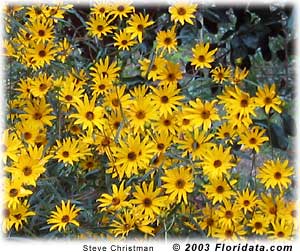
by Sheila Dunning | Oct 2, 2018
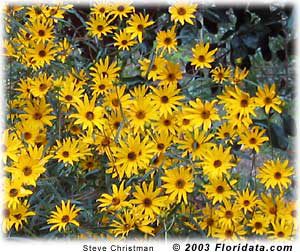 Each fall, nature puts on a brilliant show of color throughout the United States. As the temperatures drop, autumn encourages the “leaf peepers” to hit the road in search of the red-, yellow- and orange-colored leaves of the northern deciduous trees. In Northwest Florida the color of autumn isn’t just from trees. The reds, purples, yellow and white blooms and berries that appear on
Each fall, nature puts on a brilliant show of color throughout the United States. As the temperatures drop, autumn encourages the “leaf peepers” to hit the road in search of the red-, yellow- and orange-colored leaves of the northern deciduous trees. In Northwest Florida the color of autumn isn’t just from trees. The reds, purples, yellow and white blooms and berries that appear on
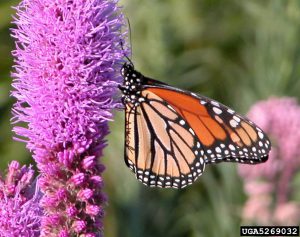
Monarch butterfly on dense blazing star (Liatris spicata var. spicata).
Beverly Turner, Jackson Minnesota, Bugwood.org
many native plants add spectacular color to the landscape. American Beautyberry, Callicarpa americana, is loaded with royal-colored fruit that will persist all winter long. Whispy pinkish-cream colored seedheads look like mist atop Purple Lovegrass, Eragrostis spectabilis and Muhlygrass, Muhlenbergia capillaris. The Monarchs and other butterfly species flock to the creamy white “fluff” that covers Saltbrush, Baccharis halimifolia. But, yellow is by far the dominant fall flower color. With all the Goldenrod, Solidago spp., Narrowleaf Sunflower, Helianthus angustifolius and Tickseed, Coreopsis spp., the roadsides are golden. When driving the roads it’s nearly impossible to not see the bright yellows in the ditches and along the wood’s edge. Golden Asters (Chrysopsis spp.), Tickseeds (Coreopsis spp.), Silkgrasses (Pityopsis spp.), Sunflowers (Helianthus spp.) and Goldenrods (Solidago spp.) are displaying their petals of gold at every turn. These wildflowers are all members of the Aster family, one of the largest plant families in the world. For most, envisioning an Aster means a flower that looks like a daisy. While many are daisy-like in structure, others lack the petals and appear more like cascading sprays. So if you are one of the many “hitting the road in search of fall color”, head to open areas. For wildflowers, that means rural locations with limited homes and businesses. Forested areas and non-grazed pastures typically have showy displays, especially when a spring burn was performed earlier in the year. Peeking out from the woods edge are the small red trumpet-shaped blooms of Red Basil, Calamintha coccinea and tall purple spikes of Gayfeather, Liatris spp.
Visit the Florida Wildflower Foundation website, www.flawildflowers.org/bloom.php, to see both what’s in bloom and the locations of the state’s prime viewing areas. These are all native wildflowers that can be obtained through seed companies. Many are also available as potted plants at the local nurseries. Read the name carefully though. There are cultivated varieties that may appear or perform differently than those that naturally occur in Northwest Florida. For more information on Common Native Wildflowers of North Florida go to http://edis.ifas.ufl.edu/ep061
by Daniel J. Leonard | Jul 3, 2018
Each time I travel to central and south Florida and observe the wonderfully flamboyant tropical flora, I am reminded of the unique and frustrating climatic characteristics of Northwest Florida. Our weather is tropical enough through the summer to sustain virtually everything our friends to the south grow, but winters north of the Big Bend are just cold enough to prevent long-term success with most tropical species. However, the genus that is maybe most synonymous with tropical color, the Hibiscus (it even has its own texting emoji!), contains several species that are hardy through our winters. The best landscape plant of these hardy Hibiscus species is creatively (sarcasm) called Hardy Hibiscus or Giant Rose Mallow (Hibiscus moscheutos) and is an absolute star in the Panhandle, bringing the beauty of the tropics to your yard!
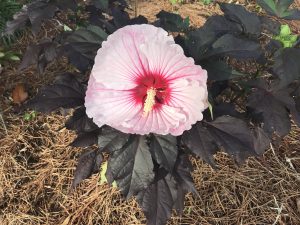
Hibiscus ‘Starry Starry Night’ – Photo courtesy Daniel Leonard
Rose Mallow is a native perennial species that occurs in sunny wetlands across the eastern U.S. This species can grow 7-8’ in height in its natural, unimproved state and possesses the largest flowers of any hardy perennial, some varieties easily eclipse 12” in diameter. Rose Mallows bloom through the heat of our long summers and return reliably each winter unfazed by frost. The flowers also happen to be a favorite of butterflies and hummingbirds and bring beneficial wildlife to the landscape. These characteristics and the trend towards the use of pollinator friendly, low-maintenance native perennials in landscapes quickly made Rose Mallow a jewel for plant breeders and now virtually all major horticultural brands have a line of Hardy Hibiscus available at garden centers, in varying sizes, flower color and leaf color/form. Recent breeding efforts have focused on introducing plants with enormous, richly colored flowers held on compact plants with attractive foliage. The results have yielded two series and three individual cultivars that I consider superior selections and are more than worthy of inclusion in your garden:
- Summerific® Series by Proven Winners. This series is comprised of four robust (up to 5’ in height) cultivars, ‘Cherry Cheesecake’ (bicolor magenta and white flowers), ‘Berry Awesome’ (purplish lavender flowers), ‘Cranberry Crush’ (a red you really have to see to believe), and ‘Perfect Storm’ (notable for its deep purple foliage).
- Luna Series by Monrovia. This series is notable for its ultra-compact (3’ in height or less) size and characteristically large flowers. It is also composed of four cultivars, ‘Luna Red’ (deep red), ‘Luna Blush’ (white, fading to pink near flower margins), ‘Luna Pink Swirl’ (pictured and my favorite, bicolor swirly flowers), and ‘Luna White’ (white with a red center).
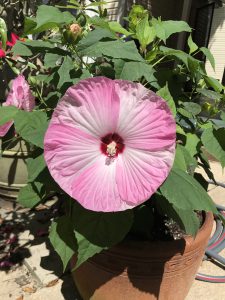
Hibiscus ‘Luna Pink Swirl’ – Photo courtesy Daniel Leonard
- ‘Starry Starry Night’ by Walter’s Gardens. (Pictured) This cultivar combines dark purple to black leaves with swirled pale and dark pink flowers. It has performed very well in my landscape and if I could only grow one, this might be it.
- ‘Lord Baltimore.’ The classic, large growing cultivar with bright red flowers that is widely available and easily found. An oldie (introduced in 1955) but a goodie.
- ‘Midnight Marvel’ by Walter’s Gardens. A “hot off the press” new cultivar that is currently difficult to find due to popularity, though some online outlets have them available in small sizes. This one is worth your patience. Sporting deep red blooms on near black foliage, there’s nothing else like it in the landscape.
In addition to being gorgeous plants, Rose Mallows are extremely versatile in the landscape and could not be easier to grow. Because the size varies so greatly (from the diminutive 30” tall ‘Luna’ series to the 8’ tall unimproved species), there really is a place for one in every garden. I like to use the smaller cultivars in large containers to facilitate moving them around where their floral display has the greatest impact or to create a tropical effect where in ground plantings are not an option (pool decks, patios, etc). The larger cultivars make spectacular specimen plantings in perennial and shrub beds and even make a really dense, striking hedge (just know they disappear in the winter). Be sure to give them as much sun as possible, as this will enhance the number of flowers on each plant and darken the foliage on the cultivars with purplish/black leaves. Too little sun will result in fewer flowers and lighter green foliage. As wetland plants, Rose Mallows enjoy regular water, either from rainfall or irrigation; they will let you know when they need it – their large leaves readily wilt under drought stress, somewhat like Hydrangea.
For low-maintenance, native, pollinator friendly, cold-hardy tropical color, you need look no further than Rose Mallow. These perennial shrubs come in all sizes and colors and fit any landscape! Look for the above listed series and cultivars at better garden centers and online retailers and enjoy the oohs and ahhs elicited when people first get a glimpse of Hardy Hibiscus in your landscape! Happy Gardening!
by Sheila Dunning | Jun 28, 2018
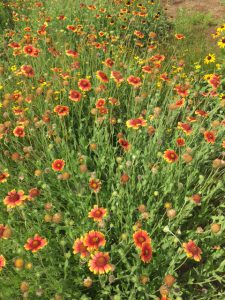 National Pollinator Week is only recognized in June, but efforts to encourage pollinators shouldn’t end then.
National Pollinator Week is only recognized in June, but efforts to encourage pollinators shouldn’t end then.
Pollination occurs when pollen grains are moved between two flowers of the same species, or within a single flower, by wind or animals that are pollinators. Successful pollination, which may require visits by multiple pollinators to a single flower, results in healthy fruit and fertile seeds, allowing plants to reproduce. Without pollinators, we simply wouldn’t have many crops!
Worldwide, approximately 1,000 plants grown for food, beverages, fibers, spices, and medicines need to be pollinated by animals in order to produce the goods on which we depend. Foods and beverages produced with the help of pollinators include blueberries, chocolate, coffee, melons, peaches, pumpkins, vanilla, and almonds.
About 75% of all flowering plants rely on animal pollinators and over 200,000 species of animals act as pollinators. Of those, about 1,000 are hummingbirds, bats, and small mammals. The rest are insects such as beetles, bees, ants, wasps, butterflies, and moths. Western honey bees are the most common.
Most species of bees don’t sting. Although all female bees are physically capable of stinging, most bee species native to the U.S. are “solitary bees,” that is, not living in colonies and don’t sting unless they are physically threatened or injured. Only honey bees are defensive and may chase someone who disturbs their hive.
It is wise, though, to avoid disturbing any bee or insect nest.
What everyone can do for pollinators:
Watch for pollinators. Get connected with nature. Take a walk, experience the landscape and look for pollinators which are most active midday in sunny, planted areas.
Reduce your impact. Reduce or eliminate your pesticide use, increase green spaces, and minimize impervious surfaces.
Plant for pollinators. Create pollinator-friendly habitat with native flowering plants that supply pollinators with nectar, pollen, and homes. For a list of plant choices go to: http://gardeningsolutions.ifas.ufl.edu/design/gardening-with-wildlife/bee-plants.html
What you can do to create a pollinator-friendly habitat:
Design your garden so that there is a continuous succession of plants flowering from spring through fall. Check for the species or cultivars best suited to your area.
Plant native to your region using plants that provide nectar for adults plus food for insect larvae, such as milkweed for monarchs. If you do use non-native plants, choose ones that don’t spread easily, since these could become invasive.
Select old-fashioned varieties of flowers whenever possible because breeding has caused some modern blooms to lose their fragrance and/or the nectar/pollen needed to attract and feed pollinators.
Install ‘houses’ for bats and native bees. For examples go to: http://edis.ifas.ufl.edu/uw290 or http://gardeningsolutions.ifas.ufl.edu/design/gardening-with-wildlife/pollinator-hotels.html
Avoid pesticides, even so-called “natural” ones such as Bacillus thuringiensis (Bt). If you must use them, use the most selective and least toxic ones and apply them at night when most pollinators aren’t active.
Supply water for all wildlife. A dripping faucet or a suspended container with a pinhole in the bottom is sufficient for some insects. Other wildlife need a small dish of water.
Provide water for butterflies without letting it become a mosquito breeding area. Refill containers daily or bury a shallow plant saucer to its rim in a sunny area, fill it with coarse pine bark, sand or stones and fill to overflowing with water.
Fun facts:
A tiny fly (a “midge”) no bigger than a pinhead is responsible for the world’s supply of chocolate
One out of every three mouthfuls of food we eat is delivered to us by pollinators.
by Mark Tancig | May 4, 2018
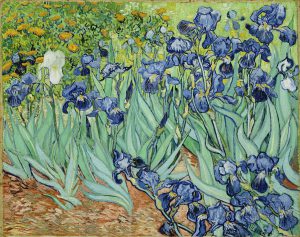
Irises by Vincent Van Gogh, 1889.
Have you noticed all of the blooming irises? Their striking shapes and colors grab my attention each time. Irises are named for the Greek word for rainbow and are often called flags. Irises, both true Iris and those with iris in the common name, are not only easy on the eyes, but also easy to grow in the Florida garden. North Florida gardeners have many varieties of iris to choose from, including those that prefer wet sites, drought-tolerant species, intricate hybrids, and native species.
All irises are in the plant family Iridaceae and have six flower petals; a lower set, called the sepals, or falls, and an upper set, known as standards, that are often upright. The base of the sepals, known as the signal, can have a variety of colors and patterns. Irises are clump forming plants with long, strap-shaped leaves. They need occasional dividing and propagate easy by rhizomes. Few pests bother them.
Here are a few common iris plants that grow well in our area.
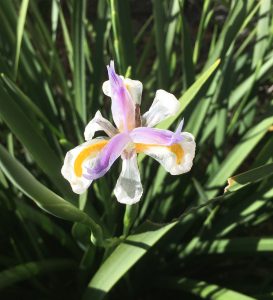
African Iris blooming on January 2nd, 2018 in the Leon County Extension Office Demonstration Garden. Credit: Mark Tancig, UF/IFAS Extension Leon County.
African Iris (Dietes vegeta)
This non-native plant is not actually a true Iris but is a tough and versatile plant. Its sepals are bright white with a yellow signal. The standards are purple. This plant can be grown in full sun or part shade, from standing water to droughty conditions. It works nicely as a border or foundation planting. Flowers only last a few days but are produced throughout the year. We had one blooming in our Demonstration Garden through a cold snap this past January. Cold weather can cause leaves to turn brown or gray, requiring some maintenance to improve appearance.
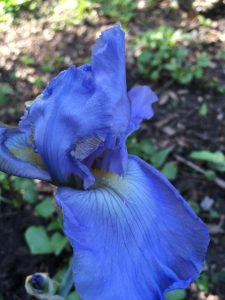
Bearded Iris. Credit: Mark Tancig, UF/IFAS Extension Leon County.
Bearded Iris (Iris x germanica)
A non-native, true Iris, bearded irises are the fancy hybrids that can come in many different colors. The “bearded” refers to the many hairs along the signal. Bearded irises prefer sunny locations and bloom in spring.
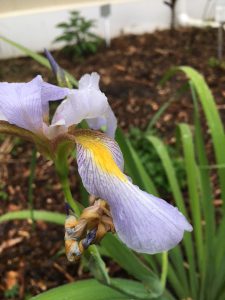
Iris versicolor. Credit: Mark Tancig, UF/IFAS Extension Leon County.
Blue Flag Iris (Iris versicolor and Iris virginica)
Two species of Iris go by the same common name, blue flag iris. These two are often misidentified in the nursery trade as well. Both have purple flowers that bloom in the spring, are native, and occur naturally in wetland areas. Gardener can have easy success with these in irrigated and/or rain gardens with some light shade. To tell the two apart requires a careful look at the lower sepals, or falls. Iris versicolor’s sepal has a greenish-yellow signal (base), surrounded by a white background with dark purple veins. The sepal of I. virginica has a bright yellow signal with little prominent veining. They also both have a 3-angled fruit.
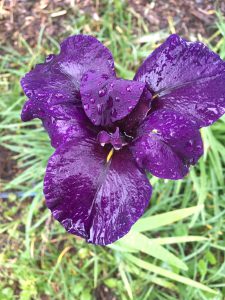
A Louisiana iris hybrid. Credit: Mark Tancig, UF/IFAS Extension Leon County.
Louisiana Iris (Iris spp.)
The name Louisiana iris refers to five true Iris species – I. brevicaulis, I. fulva, I. giganticaerulea, I. hexagona, and I. nelsonii – that are native in and around Louisiana. They easily hybridize with each other and these hybrids have become popular garden cultivars. Louisiana iris prefer moist soils and full sun.
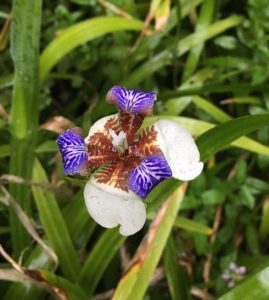
Walking Iris (Neomarica gracilis). Credit: Mark Tancig, UF/IFAS Extension Leon County.
Walking Iris (Neomarica spp.)
Another unofficial iris, most plants in the Neomarica genus share the same “walking” attribute. Small plantlets can develop at the top of the flower stalk and then fall over to start a new clump of plants. These do best in part shade to shade and have a long flowering period. They are somewhat cold tender so may die back but will return in the spring.
Yellow Flag Iris (Iris pseudoacorus)
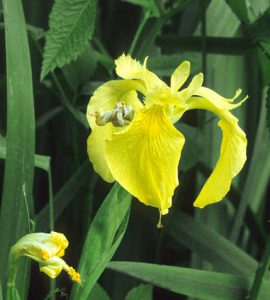
The invasive, exotic yellow iris. Credit: Ann Murray, UF/IFAS.
This non-native Iris is one that you want to keep out of the garden. Yellow flag iris is known to invade natural wetlands and has been designated invasive by the UF/IFAS Assessment of Non-Native Plants. It’s easily distinguished from the other irises listed above by its bright yellow flowers. If you have this iris, remove fruit and carefully dig out the rhizomes, place in a trash bag, and dispose of it in your solid waste bin.
For questions regarding iris identification or care, contact your local UF/IFAS Extension Office.
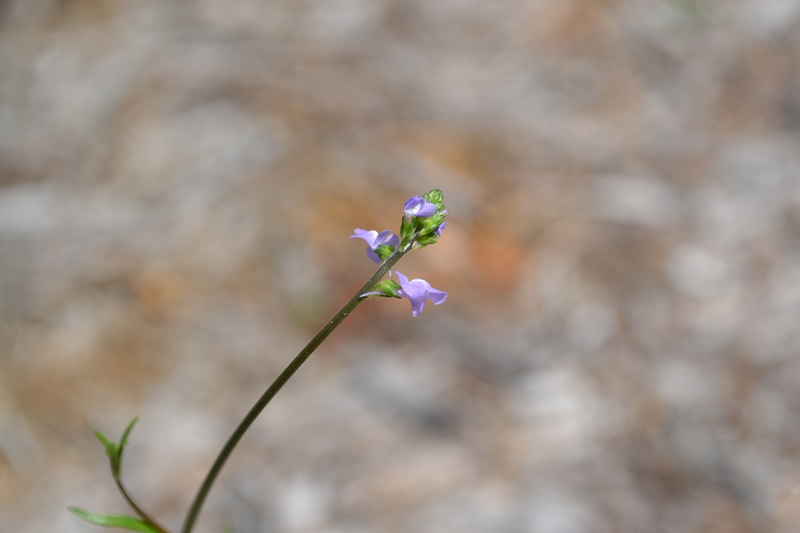
by Beth Bolles | Apr 9, 2018
The change in North Florida temperatures from cooler to warmer is making many winter weeds more noticeable as they begin to flower and form seed. Not all of these plants should be considered for mowing or hand pulling. There are several wildflowers that grow in landscape beds and thinning areas of lawns and can be enjoyed before consistent heat returns.

Toadflax flowers are held above the foliage and are light purple. Photo by Beth Bolles, UF IFAS Extension Escambia County
One very delicate wildflower that is growing now is the Toadflax, Linaria canadensis. The leaves are very small and grow low on the ground. Thin flower stalks grow several inches and are topped with light purple flowers. Although toadflax pops up in beds and lawns don’t be so quick to pull it out. This wildflower is a host to the Buckeye butterfly, one of our earlier visitors to gardens. If you look closely you may even see the tiny black, spiny caterpillar eating toadflax leaves. Visit the UF publication on the Buckeye butterfly to learn more.
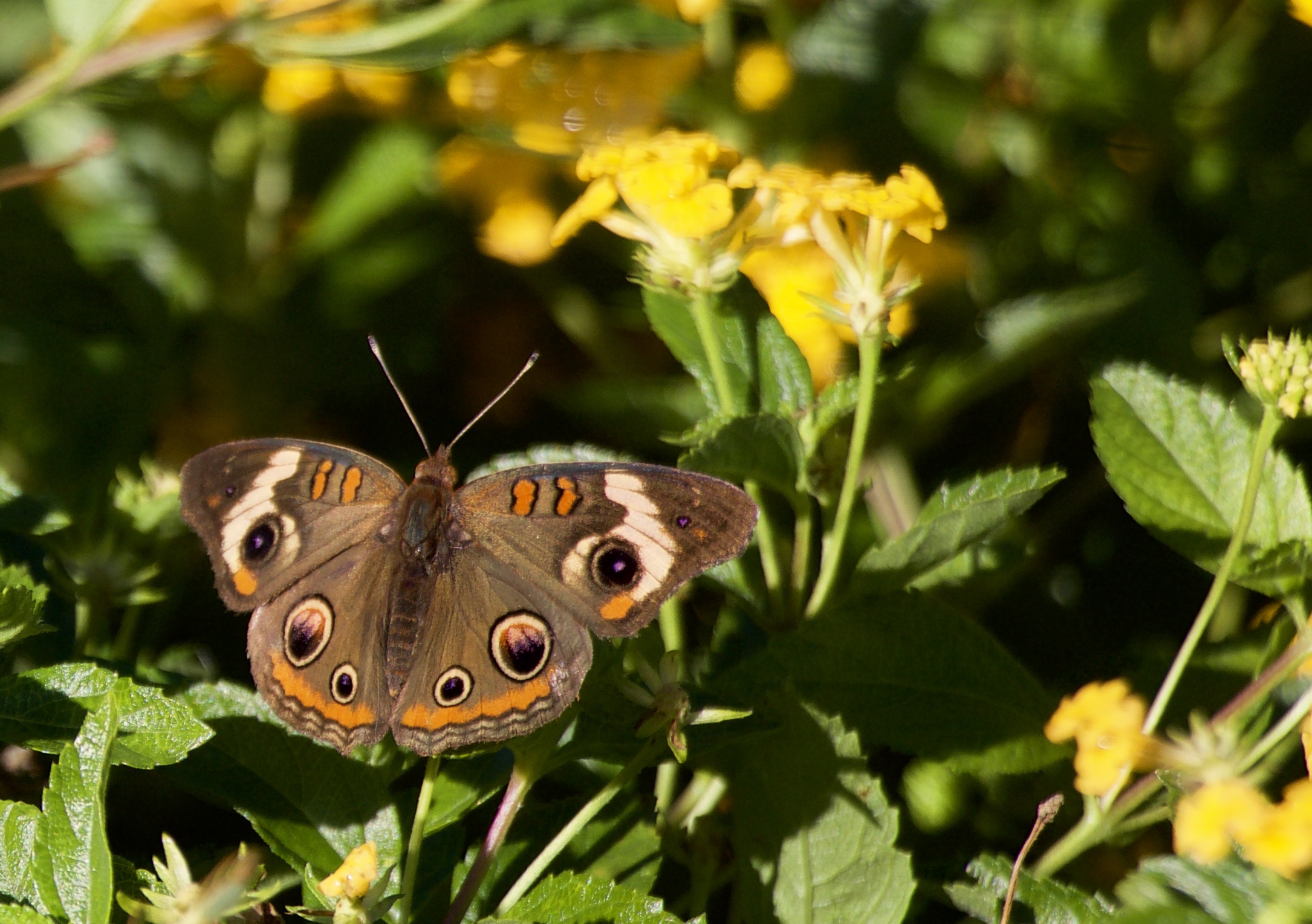
Adult buckeye butterflies are common in landscapes in early spring and late summer. Photo by Lo Sitton, UF IFAS Extension Escambia County
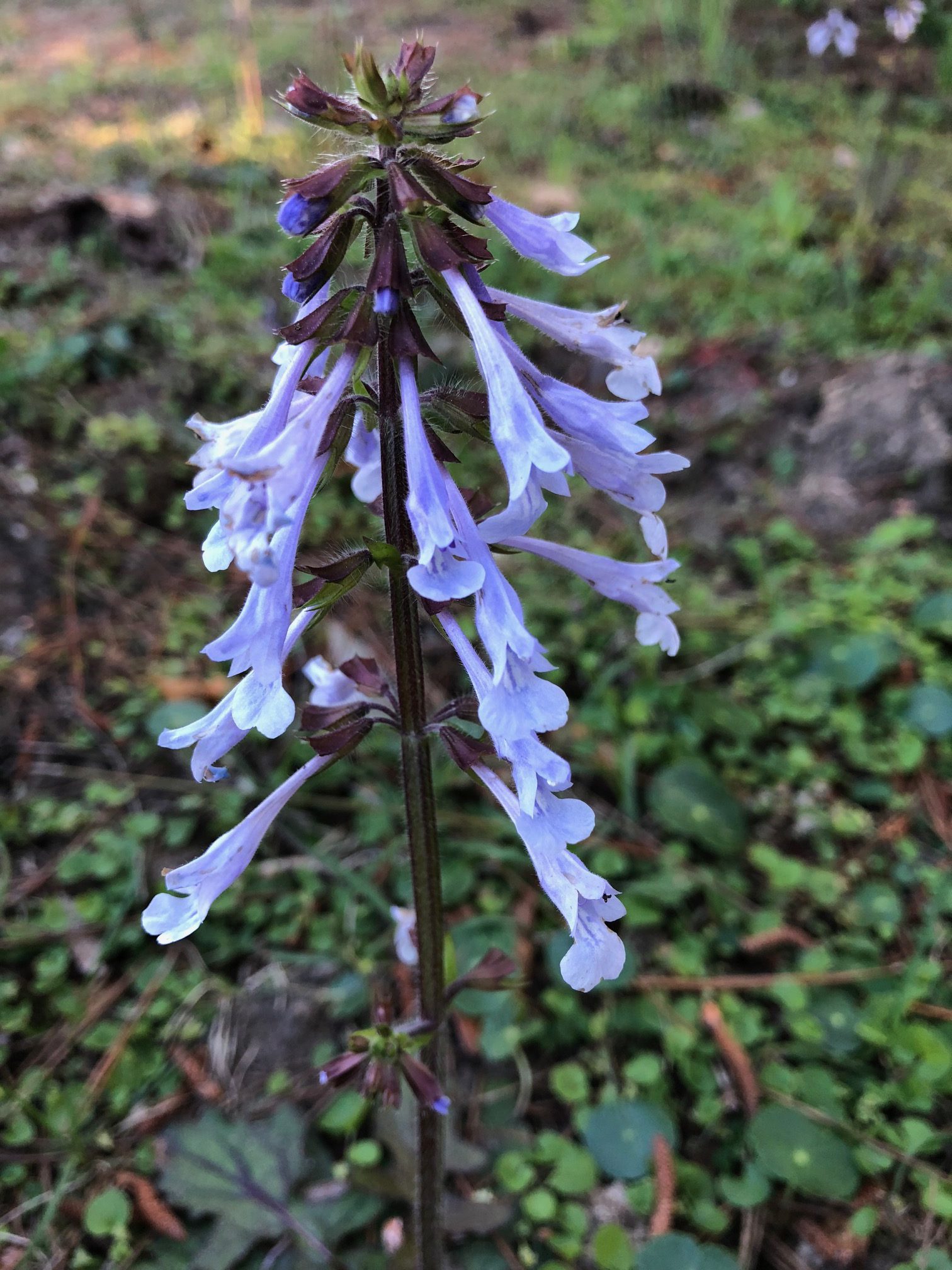
by Mary Salinas | Mar 26, 2018
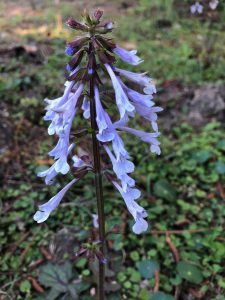
The spike of lavender blooms of lyreleaf sage. Photo credit: Mary Salinas.
Spring wildflowers are popping up along our roadways and along woodland edges. One of our native perennial beauties you can enjoy right now is lyreleaf sage, Salvia lyrata, with spikes of tubular lavender flowers rising about a foot above the ground. The blooms, which occur late winter through late spring, attract bees and butterflies and provide them a good source of nectar. It also is a good host plant for aphids, which in turn, can make it a good banker plant and feeding station for ladybug larvae.
The irregularly-shaped leaves grow in a rosette hugging the ground and can make for a natural ground cover in part shade areas. These attractive leaves are easily identifiable by their purple stems, edges and veins in sharp contrast to the bright green of the rest of the leaf. Lyreleaf sage belongs to the mint family and shares the characteristic square-shaped stems and two-lipped flowers.
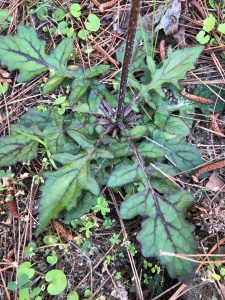
Leaves of lyreleaf sage form a ground hugging rosette. Photo credit: Mary Salinas.
Whatever garden conditions you have, lyreleaf sage should be able to adapt. It tolerates drought, flooding and most soil types. Be aware, though, that this beauty produces lots of seed and can spread quickly. This can be a very desirable trait for establishing a wildflower meadow but challenging if you want to keep it contained in a small area. To manage its’ spread, remove flower spikes after the blooms fade to prevent most seed formation.
Lyreleaf sage can usually be found in native plant or local nurseries; seed can be found through online wildflower seed sources.
For more information:
Planting and Care of Salvias in Landscapes
Florida Wildflower Foundation

 Each fall, nature puts on a brilliant show of color throughout the United States. As the temperatures drop, autumn encourages the “leaf peepers” to hit the road in search of the red-, yellow- and orange-colored leaves of the northern deciduous trees. In Northwest Florida the color of autumn isn’t just from trees. The reds, purples, yellow and white blooms and berries that appear on
Each fall, nature puts on a brilliant show of color throughout the United States. As the temperatures drop, autumn encourages the “leaf peepers” to hit the road in search of the red-, yellow- and orange-colored leaves of the northern deciduous trees. In Northwest Florida the color of autumn isn’t just from trees. The reds, purples, yellow and white blooms and berries that appear on















